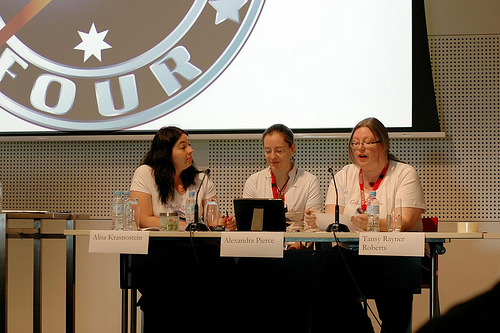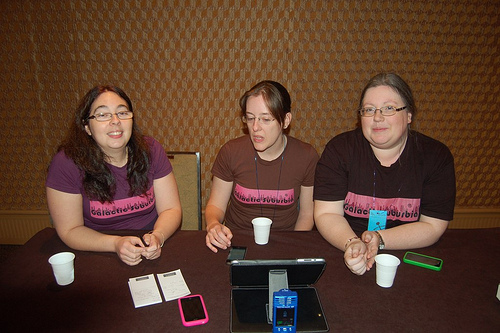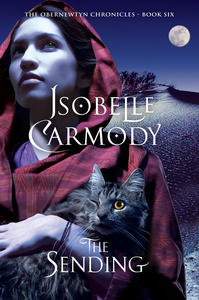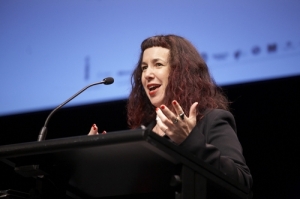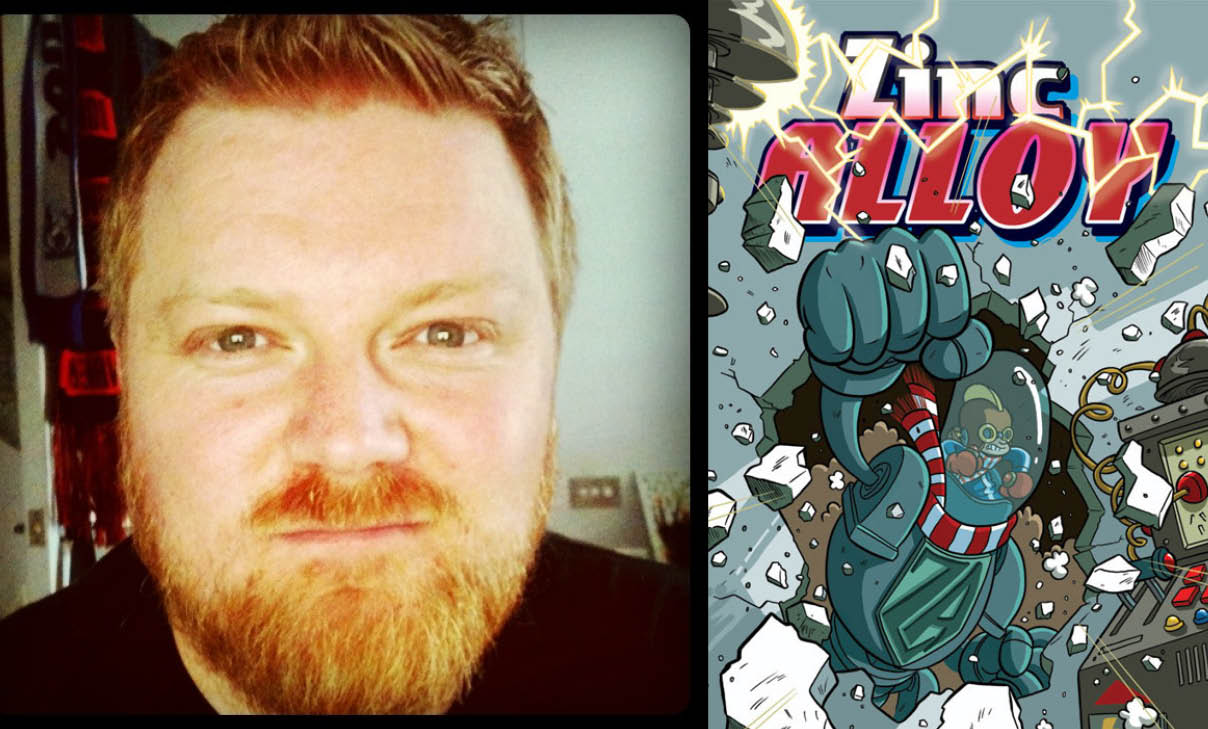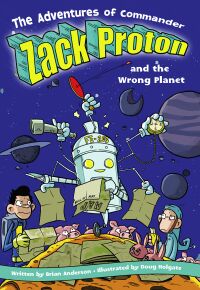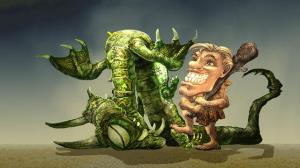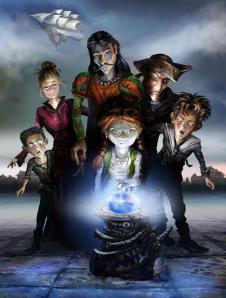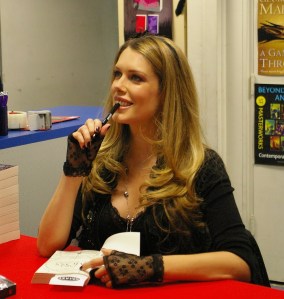Today I’m interviewing the Intrepid Team who brings you Galactic Suburbia. Fresh from the Aurealis Award win for contributing to Speculative Fiction, and hot on the heels of a Hugo nomination, we’re going to range wide and far, from motherhood, deadlines, to goals and gender.
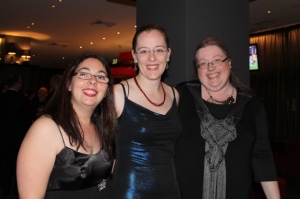
Q: First of all Congratulations on the Aurealis Award Win! The Peter McNamara Convenor’s Award for Excellence (named after Peter McNamara who was the original Aurealis Awards convenor as well as an Indie Press editor and publisher). This award celebrates work in any medium that brings credit to the field of Speculative Fiction. This must have been a buzz to win. Did some of you go to the awards night?
TANSY: it was very exciting to win it, and to hear such lovely things said about Galactic Suburbia and its effect on the community over the last few years. We all went along except Finchy who was on parenting duty back home – but it was lovely for Alex, Alisa and I to be able to celebrate together on the night.
ALEX: it was my first Aurealis Awards night and very exciting to attend. The ceremony itself was really well constructed and it was a lot of fun being there to watch people get well-deserved awards… and a lot of fun to hang out with them after as well. Getting the award was a bit surreal, since it’s a fairly big deal and to think that the conveners thought us talking to each other was worth it is amazing.
ALISA: I was really excited to attend a Sydney Aurealis Awards night and it was a lot of fun. I’m constantly blown away by the way Galactic Suburbia has been received.
Q: I now hearGalactic Suburbia has been nominated for a Hugo! (Best FanCast) Do you have any idea of the number of people who are listening to what you have to say? And does it make you feel nervous?
FINCHY: We appear to be averaging just over fourteen hundred downloads per month from our episode list with around three hundred subscribers based mainly in Australia, US, UK and Canada as well as a handful in other countries such as Sweden, Belgium and the Philippines.
ALISA: I have to admit that I try not to think too much about how many people are listening. I think that the podcast works because of the synergy between three good friends just having a conversation and so I try not to get too self conscious about it. Course, there’s no avoiding that when we record live episodes in front of an audience! Which is actually a lot of fun.
ALEX: live episodes are heaps of fun! … except when they’re too early in the morning. I admit that I like looking at the number of hits our website gets, but it doesn’t translate in my head into ‘these people actually LISTEN.’ Being nominated for the Hugo is a totally mind-blowing thing – an award that non-community people have heard of!
TANSY: What is lovely is that so many of the people who do listen to our podcast either tweet or email us, sharing their experiences and joining the conversation. I can never quite wrap my head around ‘400 people listened to that episode’ but once you get it down to about ‘5-10 people talked to us about that episode’ it feels more manageable! We can sometimes see the influence we’ve had as books/ideas we recommend or suggest get picked up by other people with their own blogs or podcasts or communities around them, which is very exciting.
Q: On the Galactic Suburbia About page you have a description of yourselves, Alex the Reviewer and Teacher, Tansy the Fantasy Writer and Mum, Alisa the Indie Publisher and Engineer. (And we should include Finchy in there as the Silent Producer). But you don’t tell us what prompted you to start Galactic Suburbia. I’m guessing you all knew each other before this. Did you have Mission Statement? To Boldly Go Where No Other Podcast Had Gone?
ALISA: We started Galactic Suburbia for a bunch of reasons. Something that the three of us are really passionate about is offering diversity of opinions and voice in the genre and we were very conscious that most of the podcasts at the time featured mostly male voices. When our favourite podcast – Starship Sofanauts – finished, we were so sad to be losing the show that we genuinely thought about picking up the gauntlet. We realised though, much as we loved the format of the show, three women on a podcast would really be a different, and our own show. So we decided to launch Galactic Suburbia – vaguely based on the Sofanauts (an emphasis on news and views on current sf publishing) but with our own, feminist, twist.
ALEX: I wanted the excuse to chat with friends that I’m lucky to see once a year. Email is nice and all, but all talking at the same time is on an entirely different level of interaction. Other than that, what Alisa said.
TANSY: We also wanted to give the Australian perspective on publishing, science fiction, etc. So often it’s the US (and to a lesser extent UK) voices which dominate the discussion, no matter what the medium. We ended up with a great deal of happy accidents that weren’t originally planned – such as how much easier it is to have a discussion about crunchy feminist issues when people aren’t leaping into your comments thread to derail you!
Also I have to say the reviewing aspect pleases me a great deal – since my second daughter came along I have so little time for reading and even less for reviewing, which saddens me because I’m well aware of how important it is to have non-US female reviewers adding their voices to the discussion. With Galactic Suburbia I have incentive to finish a book or two each fortnight, and to say something about it without having to write anything down!
Q: Can you give us a rundown on how you come up with the premise for an episode and then the mechanics of how you record it? Has this changed over time?
ALEX: When we started out, we had a three-part strategy: news first, then ‘Culture consumed’, then a ‘Pet subject.’ We quickly realised that we needed to include feedback, too, because we were actually getting some and it was nice to discuss it! While we enjoyed doing the pet subject, there were times when we couldn’t easily think of something crunchy enough to talk about… and then we discovered that we were in serious danger of going over two hours. Eventually we experimented with dropping the pet subject and giving ourselves a bit more time on the news etc; given that we do occasionally still threaten the two-hour mark, it’s probably been a good move!
TANSY: Recording wise, we all hop on to Skype. Finchy presses the buttons (I’ll let him give more specifics) and we talk straight through, barring accidents of the internet, from beginning to end. We have show notes up ahead of time in a shared Google Doc, which gives us the links to talk about in our news segment (we’ve all added to this doc in the weeks leading up to the episode), and a loose order of points of discussion, plus the works listed we’re going to review in our ‘Culture Consumed’ section. We take turns to moderate episodes, so we share the burden of trying to keep it all on track and saying things like ‘and what have you been reading, Alex.’ Then the other two hop off Skype and go have dinner/go to bed while I tidy up the Show Notes, Finchy does the editing, and ‘casts’ the episode into the internet.
FINCHY: We use Audio Hijack Pro to capture the audio from Skype for all three presenters simultaneously, after spending a little bit of time checking their relative levels. I edit in Garageband (mostly to eliminate technical glitches such as Skype dropping out) and export the compressed MP3 which is uploaded to Podbean using Cyberduck. Content editing is rare as the presenters are amazingly fluent and we like to have the feel of a natural conversation.
ALISA: The recording through unless internet accidents has added a very real “suburban” feel to our show. Listeners have positively commented on the sound of babies and barking puppies in the background. I like the idea of it sounding like the three of us sitting round a kitchen table, having a cup of tea, and life going on around us.
Q: You all have work, some have families, Alisa is running Twelfth Planet Press (and getting married this year – TR) . Like you I have work, family and deadlines. I feel like I’m running top speed just to stop from going backwards. Women can have it all, but is it worth it?
ALISA: I think women can have it all, just maybe not all at once. Is it worth it? Hell yes.
Sometimes I dream about just coming home from my day job and doing … actually, I have no idea what people without commitments do? But not often. I enjoy running my press and working with outstanding, creative people, and the intellectual challenge of it all. I enjoy the process just as much as I appreciate the rewards of my labours. I do worry about how I will fit a family in with it all and am starting to lay the preparation ground work for that now.
ALEX: I think it’s ‘all’ available, and I hope that we’re at the point where, if I don’t want to, I don’t HAVE to want it all. But I can help those of my friends who have bigger ambitions (Alisa…).
TANSY: People ask how I get it all done – how I write and balance my family responsibilities, kids, etc. “How do you do so much” It sometimes feels a bit like a veiled attack – “how do YOU do it when *I* don’t, what makes you so special?” But it comes down to priorities. You make time for writing, or fanzine editing, or convention running, or reviewing, or small press publishing, or whatever, if it’s important to you. If you love it enough. And yes, I have ambitions, mostly revolving around trying to earn a living in my field, but I don’t feel the need to have it all. Where would I put it?
I think it’s a worry how easily the idea that ‘women can have it all’ has shifted to ‘women should have it all, and if they’re not achieving perfection across every aspect of life, they should feel bad about themselves.’ I’m not a perfect mother, partner, writer, feminist or podcaster, but I’m pretty happy with my life. Galactic Suburbia gives us so much personal satisfaction right now, but I hope that if it ever becomes a chore or something to trudge through, my fellow podcasters would ditch it in a hot second and run off to find whatever else they need to make them happy. If it’s not fun, what’s the point?
ALISA: I agree – I think it’s not, how DO you fit it all in but rather how much do you want it? And which bits do you really want? Because I most definitely cut corners in my life, mostly with the boring chores, to do the things I really want.
Q: You are all in your thirties and you’re all well educated, Engineer (Alisa), Classics Phd (Tansy), History Masters and Teaching (Alex). You’ve talked about gender from the Tiptree Awards, how comics portray females and Celebrating Joanna Russ. As someone who works with young women in their twenties I’ve come across the feeling that the feminist movement is old hat and a bit of an embarrassment. How far have we come? How much farther do we need to go?
TANSY: I think that anyone who thinks feminism isn’t necessary isn’t looking at the world right now. It’s never been more relevant to the lives of young women. There are so many battles still to fight – in politics, in bodily autonomy, in law reform, in workplace equality. And yes, in publishing and science fiction too. Then there’s the challenge of intersectionality, of making sure that feminists are not trampling on the rights of others to get what they need, and that we remember that racism, homophobia and ableism are rife in our communities.
Like knitting and crochet, I like to think that feminism is coming back into vogue among the young. And books matter, just like the representation of gender in all cultural products matters – it’s how we shape ourselves as a society. Women are constantly in danger of the backlash, of being told it’s time to sit down and shut up because the men are talking. And while sexism is often (but not always) more subtle and insidious than in previous decades, it’s still with us.
Nothing makes us happier than hearing from our male listeners about how they have become readers of and advocates for women’s work because of Galactic Suburbia. Though it’s also pretty fabulous when we hear from women who have also changed their way of thinking towards feminism, the work of other women, and gender issues in general, because of us. We’re not gurus or experts in gender theory and we’re certainly not perfect feminists – we’re just showing our work as we make our own imperfect journeys forward in figuring things out for ourselves, and it’s lovely how many people want to come along for the ride.
ALISA: It makes me sad when I talk over feminism with my mum and realise that we haven’t really come anywhere near as far as maybe we should have for the time frame. On the other hand, I know so many men who have their head around the issues and are not only walking the talk, they’re active advocates. Is feminism old hat? I don’t think so. Does it need to constantly be reviewed and updated, I think yes. I think one problem is that the really overt aspects of sexism have been addressed, and hopefully mostly improved. Like you can’t not hire or promote me just because I’m getting married later this year and probably will want to start a family soon. But the battle now is to bring to light the subtle, subconscious and culturally condititioned aspects of sexism. This battle in some ways is a much harder one but at the same time, I think it’s deeply fascinating. Certainly the most positive interactions I’ve had with Galactic Suburbia is when someone has thought about something we’ve discussed and then gone away to look at their own actions, found them wanting AND then done something about that – like actively reading and talking about female writers and their work.
Alex: … all of that.
Q: Where do you see Galactic Suburbia going in the future?
ALEX: Wiscon…
TANSY: WISCON OR BUST!
ALISA: I’m with them!
Q: Individually, what would you like to achieve in the next year and in the next 5 years?
ALEX: I just want to read a lot of really good books. And talk about them.
TANSY: I want to *write* a lot of really good books. Selling some wouldn’t hurt either. I want to earn a living at this writing thing and that means getting my ambition into gear. So glad I have good friends to keep me sane along the way.
ALISA: I want to *publish* a lot of really good books. I’m looking forward to completing the Twelve Planets series, launching our new crime imprint Deadlines, and releasing our first novel. In the next 5 years? I probably want it all
See an overview of 2011 podcasts.
Catch up with Galactic Suburbia on Facebook
Catch up with Galactic Suburbia on iTunes
Catch up with Galactic Suburbia on Twitter @GalacticSuburbs
Catch up with them individually on Twitter
Tansy @tansyrr
Alisa @Krasnostein
Alex @randomisalex
Blogs
Tansy Rayner Roberts
Alisa Krasnostein
Alexandra Pierce

